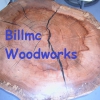I'm concentrating more at the head-end here: finding the anatomical midline of the snail, the optical 'watershed' in the design and separating the two tentacles (eye stalks) so that the front one stands completely free of the background.

| 26 June 2013 07:33
Roman - Yes, there's a lot of waste wood generated in every woodworking operation. Think of how different my snail is to the original tree! Bigger pieces that look vaguely useful go to future projects; smaller pieces to local woodturners and anyone else who might use them; smallest and chips go to lighting the fire...

| 25 June 2013 15:39
Regarding all of the waste wood, chips, chunks, etc. I imagine you save the larger pieces for potential other work but what do you do with the large volume (I assume) of waste wood you generate?

| 24 May 2013 11:39
William - I do use an Arbortech (KA equivalent) on some bigger carvings to remove waste and, you're right, it is an unpleasant experience what this the dust and bits flung out; but the main problem is that it's so quick, so dominant; it's sometimes out of synch with the speed I need to work. In this snail, big gouges and a mallet were perfect. In other carvings I may well go back and forth between one and the other.

| 23 May 2013 05:50
Chris, with so much wood to remove during this initial bosting phase of the carving - What are your thoughts on the use of power carving tools to remove this waste? I tried the King Arthur system once when I was first learning to carve chair seats and could not stand the mess so I stuck to the scorp and travisher for that task.